Is it really difficult to make 10 million yuan by trading cryptocurrencies? As a veteran who has been in the cryptocurrency circle for 10 years, I can tell you very responsibly, 'It's not difficult!'
Whether it's spot or contracts, you need to know how to take profits, especially in this bull market. As an old韭菜, I think it's very difficult, and then I start to live by trading every day (this refers to contracts). I only made some money in spot in 2023 to the end of 2024, and the rest was made by trading contracts.
If you have a position, manage your position and do it. Don't take action easily. Taking action will definitely be rewarding. Don't do long-term. Do short-wave. Control your emotions. The order should not be too much. If you want to ask me which coin can make money?
Everyone makes money when the bull market comes, it's just a question of how much, unless it's a garbage coin that keeps falling. Escaping the top is also very important, judging the approximate trend of the market, and making phased profit-taking.
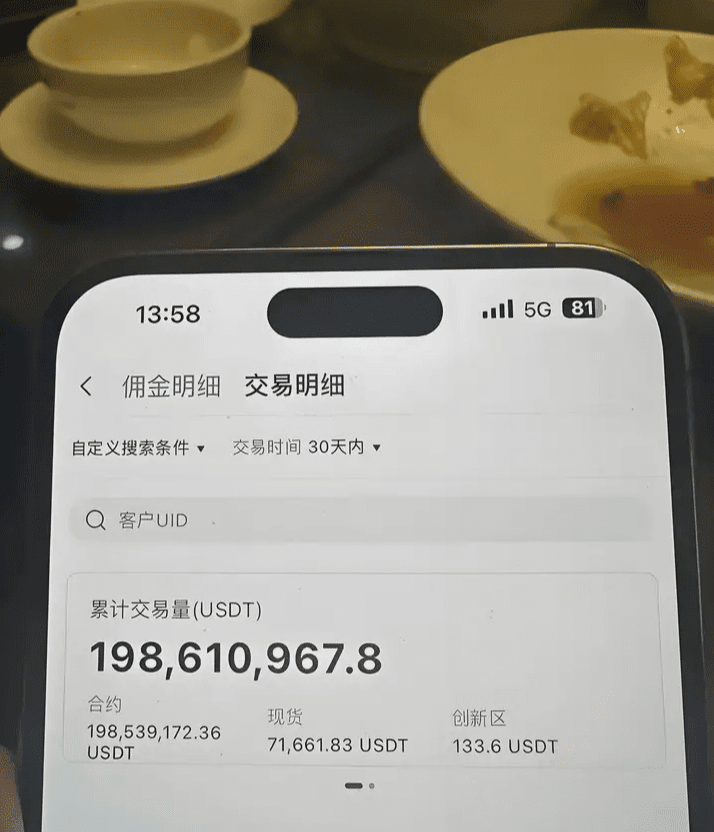
Ten years in the cryptocurrency circle, 6 years of professional cryptocurrency trading, more than 3100 days. I have done long-term, short-term, ultra-short-term, and swing trading, basically all types of methods. I have a relatively strong say on this issue.
I have always said that mastering a skill is the 10,000-hour rule, 8 hours a day, more than 200 days of review a year, almost 5 years, this is just the beginning
The foundation of stable profit. There must be a big pit within 10 years, so to be on the safe side, don't put more capital than you can afford within 10 years.
Many masters who have made tens of millions or hundreds of millions from tens of thousands of dollars just use very high leverage in contracts, and many of them die in a bear market. It's just that you don't know it. Human nature often makes people lose the ability to judge correctly in the face of big trends.
I am the instructor, experienced in multiple bull and bear markets, and have rich market experience in multiple financial fields. Follow the official account (比特行者). Here, penetrate the fog of information and discover the real market. Seize more wealth password opportunities and discover truly valuable opportunities. Don't miss out and regret it!
1. Essential Preparations for Becoming a Full-Time Trader (Must-Read for Novices!)
In the field of trading, many people dream of becoming full-time traders, after all, it is very tempting to make money at home by moving computers and mobile phones. But in fact, only a few people can continue to make profits in trading and persist.
However, as long as you persevere, becoming a full-time trader is indeed enviable. I don't have any trading talent myself, and my grades were not good when I was a student, but I can break through the trading dilemma, and I believe everyone can do it too. Next, based on my experience, I will talk about the key points to prepare before becoming a full-time trader.
Beginner Start: Novices who are new to trading should never put all their capital into a trading account. Initial trading is likely to result in losses. Based on the experience of training traders, I recommend that novices invest a small amount of capital first. Be prepared to lose it all and accumulate the most lessons with the least amount of money.
Trading Accumulation: After mastering your own trading strategy and theory, and building a trading system (you can refer to previous articles to learn about the construction method), you can start a 6-month recording phase. It is quite good to be able to make stable profits within 6 months. During this period, you do not pursue explosive profits. It is rare to be able to profit. After completing these 6 months, you can start preparing to become a full-time trader.
Full-Time Preparation: Deciding to trade full-time requires two financial preparations.
First, list monthly expenses, multiply by 12 to get annual expenses, and prepare this money for daily expenses.
Second, prepare trading capital.
This is because trading is not profitable every month. It is possible to lose money for two consecutive months, but the third month may reap 6 months of profit. This is the norm in trading. If you go bankrupt and quit your job to trade, you will face a lot of psychological pressure in the face of early losses, which will lead to wrong decisions, and mentality is crucial to trading. Making these preparations can easily start a full-time trading career.
2. This is the most complete and easy-to-understand strategy guide I have ever seen: Exponential Moving Average Trading Strategy
We know that there are many variations of Moving Averages, such as:
Simple Moving Average
Weighted Moving Average
HUll Moving Average
Arnaud Legoux Moving Average
So, what is so special about Exponential Moving Average (EMA)?
Most importantly, which period is the best to use for exponential moving averages?

In this article, let's talk about the issue of "exponential moving averages".
What is an Exponential Moving Average and How Does it Differ from a Simple Moving Average (SMA)
There is no doubt that the simple moving average is very simple to calculate.
Step 1: Determine the closing price for the selected period
For example, you are using a 10-period simple moving average on the daily chart.
Find the closing price for the past 10 days.
Taking KIRK's daily chart as an example, the closing prices for the past 10 days are:
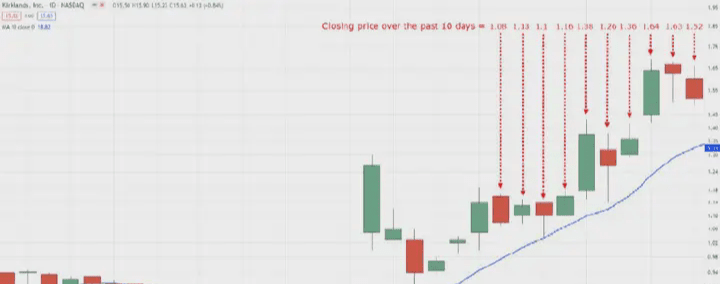
Step 2: Add up all the closing prices
The sum of all closing prices on the KIRK daily chart is:
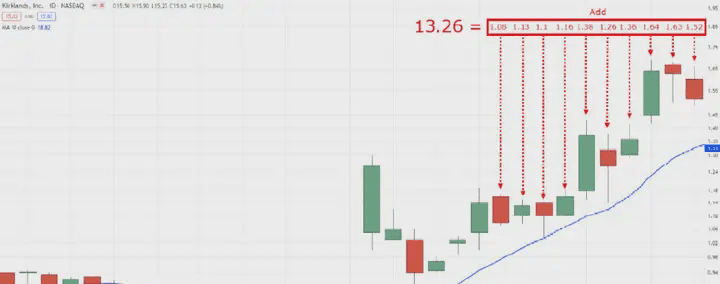
As you can see, the sum of the closing prices of the past 10 K-lines is 13.26.
Step 3: Divide by the selected number of periods
Basically, divide 13.26 by 10 (i.e., your moving average period).
You will get the value of the simple moving average as 1.33.
The final moving average on the KIRK daily chart is:
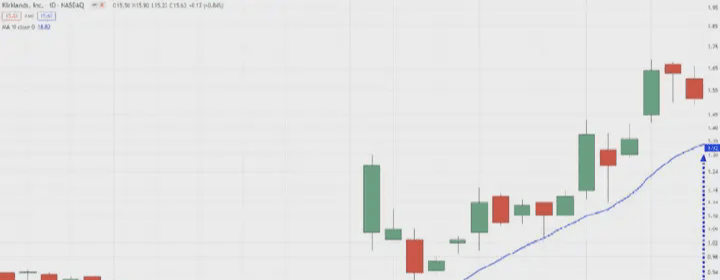
Is this very simple?
So, let's talk about exponential moving averages (some people also call them exponentially weighted moving averages).
What is an Exponential Moving Average? How to Calculate an Exponential Moving Average?
The formula for exponential moving averages is much more complex.

This does require some effort to understand.
However, you don't need to worry about the formula or look for an exponential moving average calculator.
Just load the indicator into your trading software and start using it.
The purpose of the exponential moving average formula is to make the "weight" of the current price higher and more sensitive to it. This way, it is not as lagging as a "lagging indicator".
You can clearly see the difference in the following figure:
Comparison of EMA and SMA on KIRK Daily Chart:
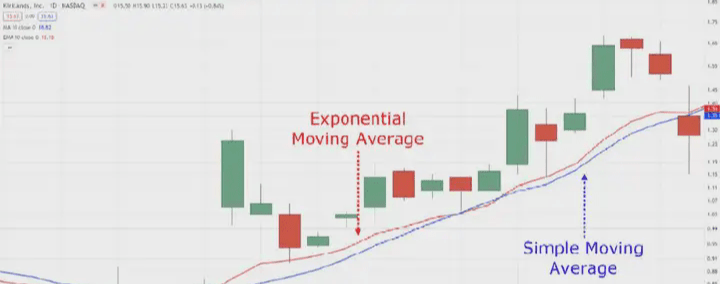
Let's get straight to the point and see why many traders lose money when using exponential moving averages...
Why You Lose Money Using Exponential Moving Averages
When I first learned about technical indicators, I was simply fascinated by them.
I felt that putting these indicators on the chart made me feel powerful, and the market should submit and "respect" these indicators.
But the truth is... technical indicators like exponential moving averages are not "crystal balls", they are just tools!
So what is the role of a tool?
Of course, it is to help you simplify tasks and get the job done!
The same goes for exponential moving averages.
You must use these indicators in a way that does not make analysis and trading too complicated, and use them appropriately.
However, many traders use exponential moving averages in the wrong way, for example...
Using the indicator with other related indicators
I'm sorry to tell you that stacking more indicators on the chart, no matter how "confident" you are, cannot guarantee a profitable trade.
Such as MACD.
It's not really reasonable to use it with an exponential moving average.
Why?
Because MACD is essentially a combination of exponential moving average formulas!
MACD formula on the Euro/USD daily chart:
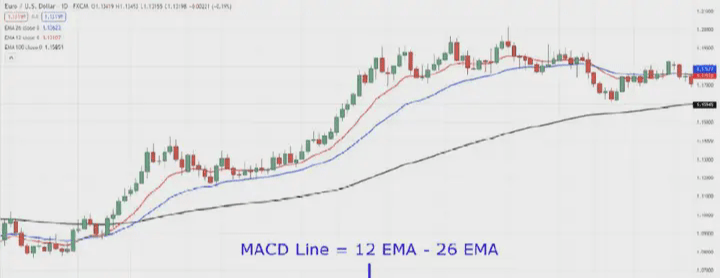
So, if the exponential moving average on your chart shows a bullish signal, and the MACD indicator shows a bearish signal...
It's like there's an EMA civil war going on on your chart, and you're at a loss as to what to do.
So what should you do?
It's simple, choose one indicator for each purpose.
For example:
◎ One indicator for trend filtering ◎ One indicator for entry triggers ◎ One indicator for determining initial stop loss ◎ One indicator for determining trailing stop
I'll explain this in detail later, but for now, remember this principle:
One purpose, one indicator.
Trading in Oscillating Markets
Summary in one sentence: Exponential moving averages should be used in trending markets.
Why?
Because when you use this indicator in an oscillating market...
It doesn't matter whether you're using a 10, 20, 50, or 200 period EMA.
Performance of EMA in an Oscillating Market in CADCHF Daily Chart:
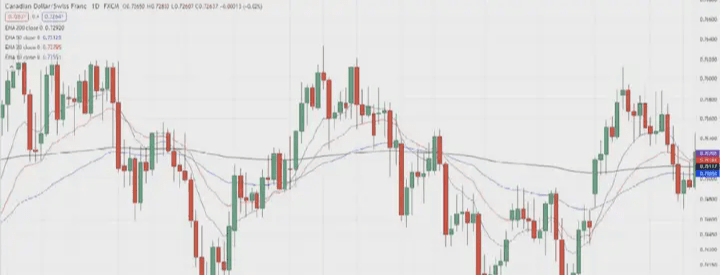
Oscillating markets can greatly reduce the effectiveness of exponential moving averages.
Because the price will repeatedly ignore and "break through" these indicators.
Instead, you should only use it where the exponential moving average is respected - that is, in trending markets.
Performance of EMA in a Trending Market in EURUSD Daily Chart:
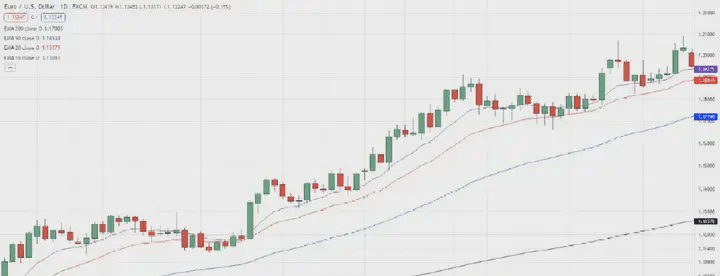
Can you see the difference?
Very obvious, right?
However, that's not enough.
Because another mistake traders make when using exponential moving averages is...
Using Too Short of a Period in a Volatile Trend
I understand, you may like to try different indicator settings.
I also know that you may not have the patience to deal with long-term trading.
So, what would you do?
You might tend to "scalp" on the 1-minute chart, or use very short indicator parameters, such as 5-period and 10-period exponential moving averages.
But sometimes, even using these methods in a trending market can do more harm than good.
Performance of Short-Period EMA in a Volatile Trend Market in INRUSD Daily Chart:
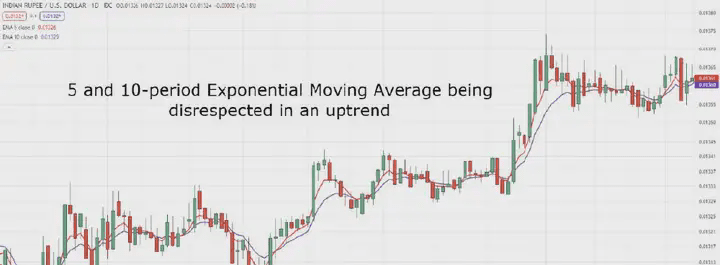
"What? I thought exponential moving averages were best used in trending markets?"
"Why is it still not working?"
Let's analyze what happened.
You used a shorter period exponential moving average.
At the same time, you are trading a highly volatile market.
These two don't match, do they?
So, should you use a longer period indicator in a volatile market?
Performance of Long-Period EMA in a Volatile Trend Market in INRUSD Daily Chart:
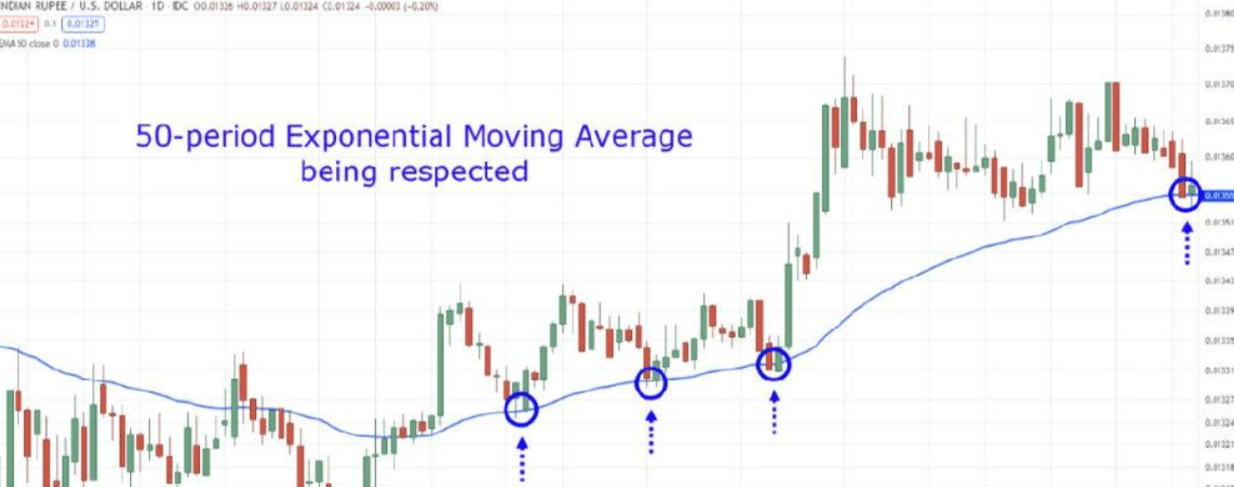
And using a shorter period when the market is in a parabolic trend?
Performance of Tight-Period EMA in a Parabolic Trend in USDTRY Daily Chart:
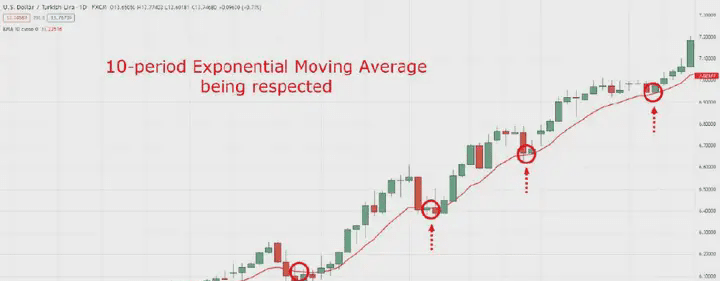
That's much better, right?
So now, I'm sure there's a burning question in your mind:
"Which exponential moving average period should I use?" "What about a 69-period exponential moving average?" "What about a 72-period one? Which one is the best?"
Next, we'll discuss this in more detail...
How to determine which exponential moving average period to use
If I were to write an article: The 10 Most Asked Questions in Trading of All Time...
The question of 'which exponential moving average period is the best' would definitely be on the list.
But the truth is:
Even if I tell you the answer directly, it won't make any substantial improvement to your trading.
Why?
Because you're too focused on 'what' is the best period, rather than 'why' you should choose a certain period.
You might ask, what do I mean?
What I mean is, you need to understand the background of the concept and choose the exponential moving average period that you think is appropriate based on your trading method.
And the best way to start is to understand the characteristics of the trend you want to capture:
Weak Trend Good Trend Strong Trend
Then find the 'right' exponential moving average period for these types of trends.
Let me give you an example...
Weak Trend
This type of trend is essentially a long-term trend, usually with high volatility and many 'false breakouts', looking like this:
Weak Trend in EURJPY Daily Chart:
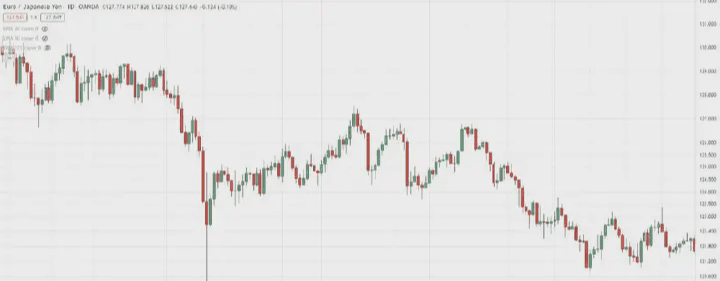
In this case, it is obviously meaningless to use a short-period exponential moving average of 10 or 20 periods, right?
Performance of Short-Period EMA in a Weak Trend in EURJPY Daily Chart:
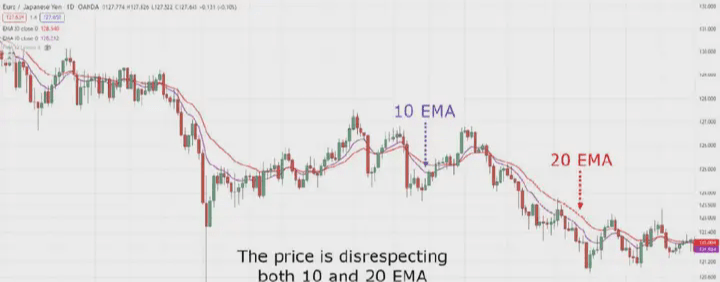
Conversely, if you want to capture a weak (but long-term) trend, you should use an exponential moving average between 100 and 200 periods.
Performance of Long-Period EMA in a Weak Trend in EURJPY Daily Chart:
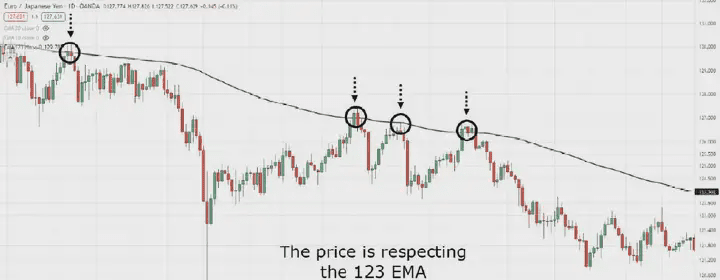
The reason I said "between 100 and 200 periods" is because it doesn't matter whether you choose 120, 199, or 123 periods. The key is that the period is long enough to capture this type of trend.
Do you understand?
Good Trend
Good trends, also known as medium-term trends, are suitable for traders who want stable but slow returns, especially trend followers.
Good Trend in EURJPY Daily Chart:
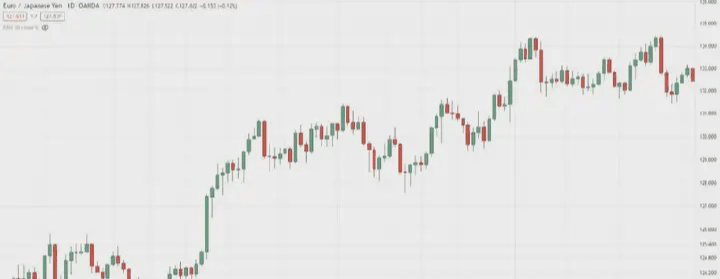
As a trend follower, it's always exciting to see a good trend and should be taken advantage of!
However, using a 50 to 100 period exponential moving average to capture a good trend is a 'reasonable' choice.
Medium-term EMA cycle performance of a good trend in the EURJPY daily chart:
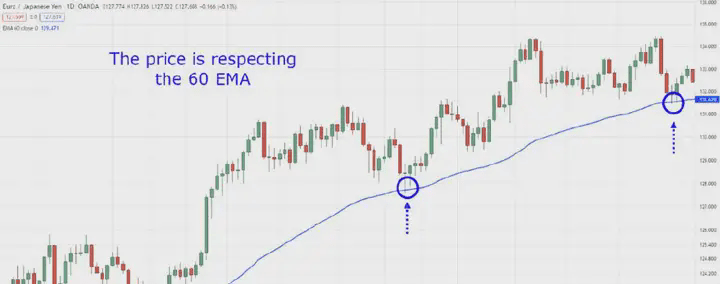
Strong Trend
Strong trends usually appear in markets that are highly sought after by a large number of traders and the media, and are also where many new traders flock.
Strong Trend in BTCUSD Daily Chart:
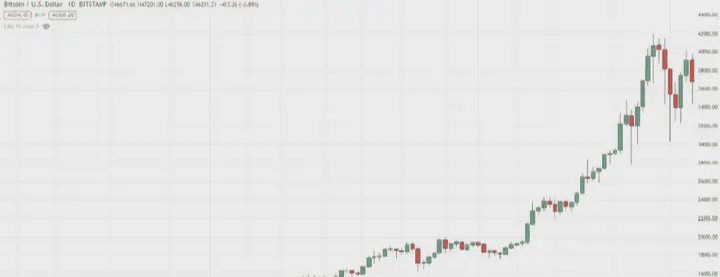
These short-term trends should not be considered investment opportunities, as they can quickly reverse at any time.
But you, as a momentum trader, can profit from them by using a 10 to 20 period exponential moving average.
Short-term EMA Cycle Performance of a Strong Trend in BTCUSD Daily Chart:
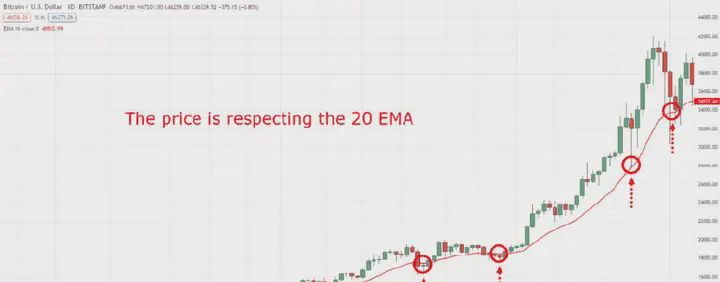
This is an objective way to help you choose the exponential moving average period that is right for you.
Again, you need to first determine the type of trend you want to capture, and then choose the relevant period for those trends.
At this point, you may be thinking:
"Well, that sounds good, but you haven't really taught me how to enter a trade with an exponential moving average."
You're right!
But everything you've learned so far points to the next section:
How to use exponential moving averages for trading entries and exits.
How to Use Exponential Moving Averages Like a Pro
For most traders, the exponential moving average is just a regular indicator used to filter signals or exit trades.
But as someone who has been using it for years...
I'm going to share with you the versatility of this indicator, and how it's enough to deal with trading using just this one indicator.
Let's get started!
How to Use Exponential Moving Averages as a Trend Filter
This is probably the most common way exponential moving averages are used.
But there is one question that many traders have not asked:
Do you really need a trend filter?
The answer is: Yes!
When do you need it?
When you plan to trade both long and short positions at the same time, such as in the Forex market.
Performance of Using EMA as a Trend Filter in GBPUSD Daily Chart:
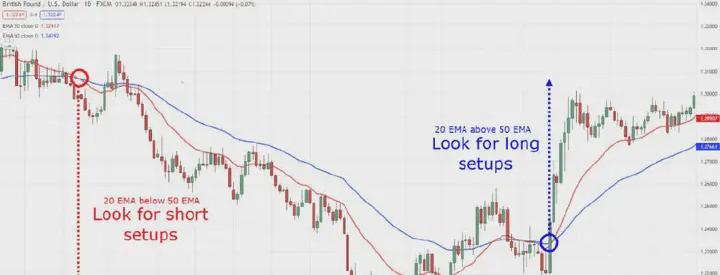
Basically, whether you want to go long or short, using a trend filter can be your main "button"!
How to Use Exponential Moving Averages for Trade Entry
Remember in this article, I have repeatedly emphasized that the price should respect the exponential moving average?
Because this is where you can objectively grasp the entry timing. The exponential moving average is the "value area" in various trends.
So, how exactly should you grasp the entry timing?
Step 1: Wait for the price to fall below the exponential moving average that has been respected at least twice.
Two Tests of the 20-period EMA on the NZDUSD Daily Chart:
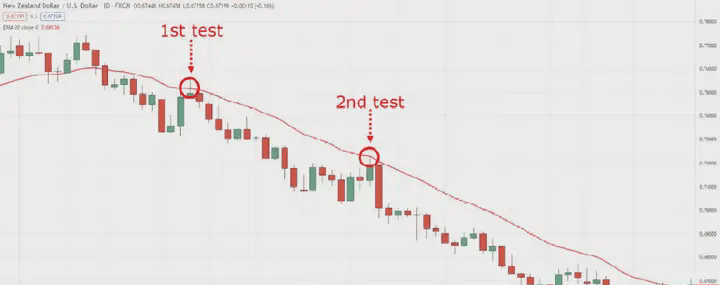
Step 2: Wait for the price to close back above the exponential moving average.
The price on the NZDUSD daily chart closes back above the 20-period EMA:
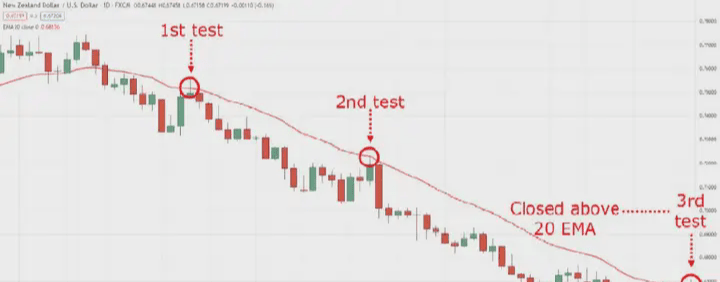
Step 3: Enter the trade at the opening of the next K-line.
The price on the NZDUSD daily chart closes back below the 20-period EMA again:
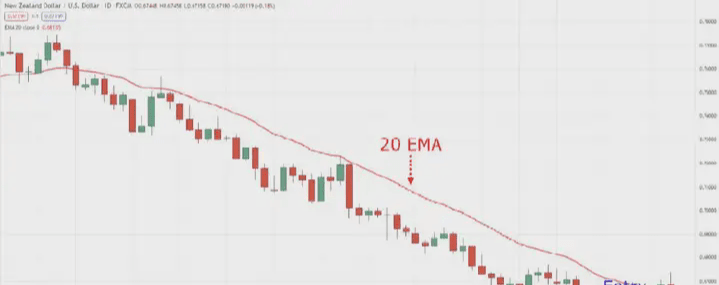
Isn't it simple and objective?
How to Use Exponential Moving Averages for Trade Exits
The best thing about exponential moving averages is that they are a very versatile tool.
This means that your entry method can also be applied to exits!
The method is simple, just wait for the price to close outside the exponential moving average.
Trailing Stop Performance of 20-period EMA on USDZAR Daily Chart:
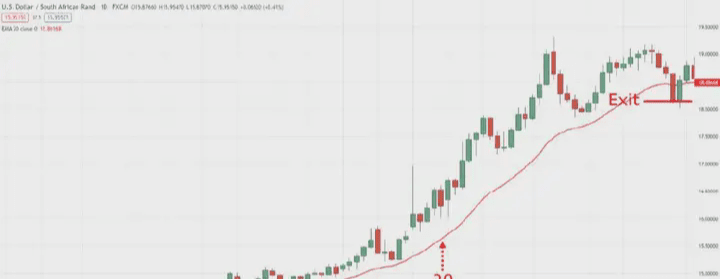
This makes the exponential moving average a reliable trailing stop tool because it doesn't limit your profits.
But then again...
Be sure you know what type of trend you want to capture, and then set your exponential moving average period as a trailing stop based on that!
Using Exponential Moving Averages in Strong Markets
The fact is, market conditions are constantly changing.
Therefore, not all strategies are effective at all times!
So, when you're stuck in a losing cycle, instead of asking yourself:
"Is my method of using exponential moving averages effective?"
You might as well ask yourself:
"Am I trading in the right market conditions?"
Because sometimes the problem is not with the techniques and indicators, but with the market conditions themselves!
You might ask:
"Well, how do I find a strong market that is suitable for using exponential moving averages?"
Let me answer that for you.
Forex Market
If you trade the Forex market, you need to consider using a currency strength indicator.
It will tell you which currency pairs are strong and which are weak, so you can "pair" them for trading.
For example:
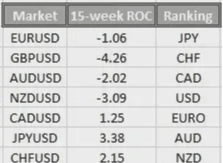
As you can see, the strongest currency pairs are JPY and CHF, and the weakest are NZD and GBP.
Therefore, you can consider trading GBPJPY or NZDCHF.
I won't go into detail here on how to create your own currency strength indicator.
Summary
◎ Compared to simple moving averages, exponential moving averages are more sensitive in their calculations and give more weight to current prices.
◎ Using exponential moving averages in trend-following trading and avoiding pairing them with related indicators can improve trading results almost immediately.
◎ The period of exponential moving averages should depend on the type of trend you want to capture (strong trend, good trend, weak trend).
◎ Exponential moving averages are versatile technical trading indicators that can be used for trend filtering, trade entry, and trailing stops.
The above is the entire content of this guide, I hope you can learn something that is beneficial to your trading from this article.
3. Cryptocurrency Beginner's Guide to Reversing the Situation: A Secret to Wealth Surge Starting from 60,000
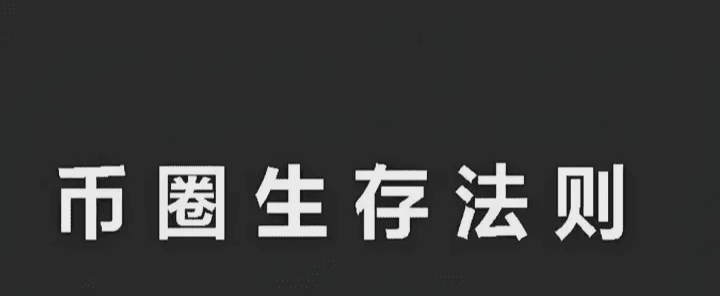
In the realm of cryptocurrency, a space filled with both opportunities and risks, I have weathered 10 years of trials and tribulations, accumulating invaluable experience. Today, I am in a great mood and have decided to share some of the essential tips for trading cryptocurrencies with everyone.
Suppose you have $60,000 in pure profit and plan to use it as your starting capital in the cryptocurrency market. How should you plan your investments? Take Bitcoin as an example: open a position when the price of Bitcoin is $10,000, adopt a segregated margin mode, set a 10x leverage, but only use 10% of the total capital as margin, i.e., $6,000, which is effectively equivalent to a 1x leverage. At the same time, set a 2% stop-loss line. If the stop-loss is triggered, the loss will only be 2%, i.e., $1,200. Those who experience liquidation in the crypto world often fail to set up positions and stop-losses reasonably. Even in the worst case of liquidation, the maximum loss is only the $6,000 margin invested, and it will never lead to losing all $60,000.
If the price of Bitcoin climbs to $11,000, you can use 10% of your total capital to open a position again, setting a 2% stop-loss as well. Even if you unfortunately hit the stop-loss, you can still get an 8% profit. Who says that investing in cryptocurrencies is highly risky? As long as the operating strategy is appropriate, the risk is completely controllable.
The 'rolling position' mentioned here can be more easily understood as 'adding to a position with floating profits'. In the operation process, it is not necessary to always maintain a high leverage of 5 to 10 times, maintaining a leverage of two or three times is sufficient. The key is to use floating profits to add to the position, and always keep the total position at a level of two or three times. Following this method to invest in Bitcoin will significantly improve security. As long as you have enough patience, time will become the engine of your wealth growth. The profit brought by adding to the position with floating profits is quite considerable. If you can successfully operate it a few times, earning millions of dollars is not out of reach. Of course, the rolling position operation cannot be carried out arbitrarily, and opportunities with high certainty must be sought. Usually, this opportunity appears after the price of Bitcoin plummets and enters a sideways consolidation phase. After multiple attempts to bottom out, there are signs of an upward breakthrough. At this time, the probability of Bitcoin entering an upward trend is extremely high.
If your goal is to earn $1 million, an initial investment of $100,000 is actually possible, and this $100,000 can achieve relatively risk-free operations. Specifically, invest $100,000 first, and patiently wait for the so-called "retail investor killing" opportunity in the cryptocurrency circle. At this time, purchase spot goods. If the operation is correct, you can earn a profit of $100,000. Then, take $50,000 from this $100,000 profit for risky investment. To obtain high returns, a necessary spirit of adventure is indispensable. When an excellent opportunity arises, decisively adopt a rolling position strategy and operate with two or three times leverage. One or two successful rolling position operations may achieve the goal. If the investment fails and the $50,000 profit is lost, then take another $50,000 from the remaining profit to continue trying. If all the profits are lost, then stop the loss in time and continue to accumulate profits based on the $100,000 principal.
The whole process seems simple, but it requires extraordinary patience. Patiently wait for the right opportunity, patiently execute each step of the operation, and then you can achieve steady growth of wealth in the complex and volatile cryptocurrency market.
4. Conclusion
These insights all come from my ten years of hard work in cryptocurrency trading. They are profound understandings after experiencing wind and rain. May they illuminate the way forward for you. Produced by Lao Qi, quality guaranteed!